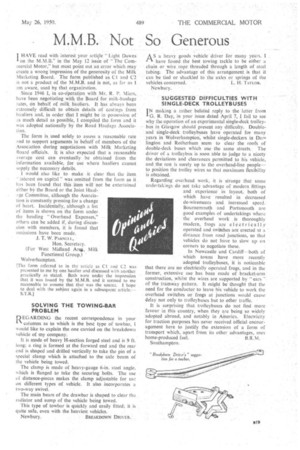M.M.B. Not So• Generous
Page 53

If you've noticed an error in this article please click here to report it so we can fix it.
I HAVE read with interest your. article Light Dawns on the M.M.B.' in the May 12 issue of "The Commercial Motor," but must point out an error which may create a wrong-impression of the generosity of the Milk Marketing Board. The form published as Cl and C2 is not a product of the M.M.B. and is not, as far as I am aware, used by that organization.
Since 1946 I, iii co-6peration with Mr. R. P. Miers,. have been negotiating with the Board for milk-haulage rates, On behalf of milk haulier's. It has always been extremely difficult to obtain &lads of castings from hauliers and, in order that I might be in possession of as much detail as possible, I compiled the form and it was adopted nationally by the Road Haulage Association.
The form is, used solely to assess a reasonable rate and to support arguments in behalf of members of the Association during negotiations with Milk Marketing Board officials. It is also expected that a reasonable average cost can eventually . be obtained from the information available, for use where hauliers cannot supply the necessary :details.
I would. also like to make it clear that the item interest on capital" was omitted from the form as it tas been found that this item will not be entertained either by the Board or the Joint Haulage Committee, although the Association is constantly pressing for a change of heart. Incidentally, although a list of items is shown on the form under the heading "Overhead Expenses," others can be added if, during discussion with Members, it is found that omissions have been made.
J. T. W. PARNEE 1, Hon. Secretary.
(For West Midland Arag, Milk Functional Group.) Wolverhampton.
The form referred to in the article as CI and C2 was presented to me by one haulier and discussed with another practically as stated. Both were under the impression that it was issued by the M.M.B. and it seemed to me reasonable to assume that that was the source. I hope to deal with the subject again in a subsequent article.- SOLVING THE TOWING-BAR PROBLEM
REGARDING the recent correspondence in your
columns as to which is the best type of towbar, would like to explain the one carried on the breakdown vehicle of my company.
It is made of heavy H-section forged steel and is 9 ft. long; a ring is formed at the forward end and the rear end is shaped and drilled vertically to take the pin of a special clamp which is attached to the axle beam of the vehicle being towed.
The clamp is made of heavy-gauge 6-in steel angle, w.hich is flanged to take the securing bolts. The use of distance-pieces makes the clamp adjustable for use on different types of vehicle. It also incorporates a two-way swivel.
The Main beam of the drawbar is shaped to clear thz radiator and sump of the vehicle being towed.
This type of towbar is quickly and easily fitted: it is quite safe, even with the heaviest vehicles.
Newbury. BREAKDOWN DRIVER.
A S a heavy goods vehicle' driver for many years, I have found the best towing tackle to be either a chain or wire rope threaded through a length of steel tubing: The advantage of this arrangement, is that it can be -tied or shackled to the axles or springs of the
vehicles concerned, L. H. TAYLOR. Newbury.
SUGGESTED' DiFFrCULTIES WITH SINGLE-DECK TROLLEYBUSES
I N making a rather belated reply to the letter from G. R. Day, in your issue dated April 7, I fail to see why the operation of an experimental single-deck trolleybus in Glasgow should present any difficulty. Doubleand single-deck trolleybuses have operated for many .years in Wolverhampton, whilst single-deckers in Data, lington and Rotherham seem to clear the roofs of double-deck buses which use the same streets.. The driver of a trolleybus is soon able to judge to a nicety the deviations and clearances permitted to his vthicle, and the rest is sorely up to the overhead-line people'— to position the trolley wires so that maximum flexibility is obtained.
Regarding overhead work, it . is strange that some undertakings do not take advantage of modern fittings and experience in layout, both of which have resulted in decreased de-wirements and increased speed. Bournemouth and Portsmouth are good examples of undertakings where the overhead work . is thoroughly modern, frogs are electrically operated and switches are erected at a distance from road junctions, so that vehicles do not have to slow up on corners to negotiate these.
In Newcastle and Cardiff—both of Which towns have more recently adopted trolleybuses, it is noticeable that there are no electrically operated frogs, and in the former, extensive use has been made of bracket:-arm construction, whilst the wires are supported by "cars " of the .tramway pattern. It might be thought that the . need for the conductor to leave his vehicle to work the overhead switches or' frogs at junctions would cause delay not only to trolleybuses but to other traffic.
It is surprising that trolleybuses do not find more favour in this country, when they are being so widely adopted abroad, and notably in America. Electricity for traction purposes has never received Official encouragement here to justify the extension of a form of transport which, apart from its other advantages, uses
home-produced fuel. B.R.M. Southampton.




























































































